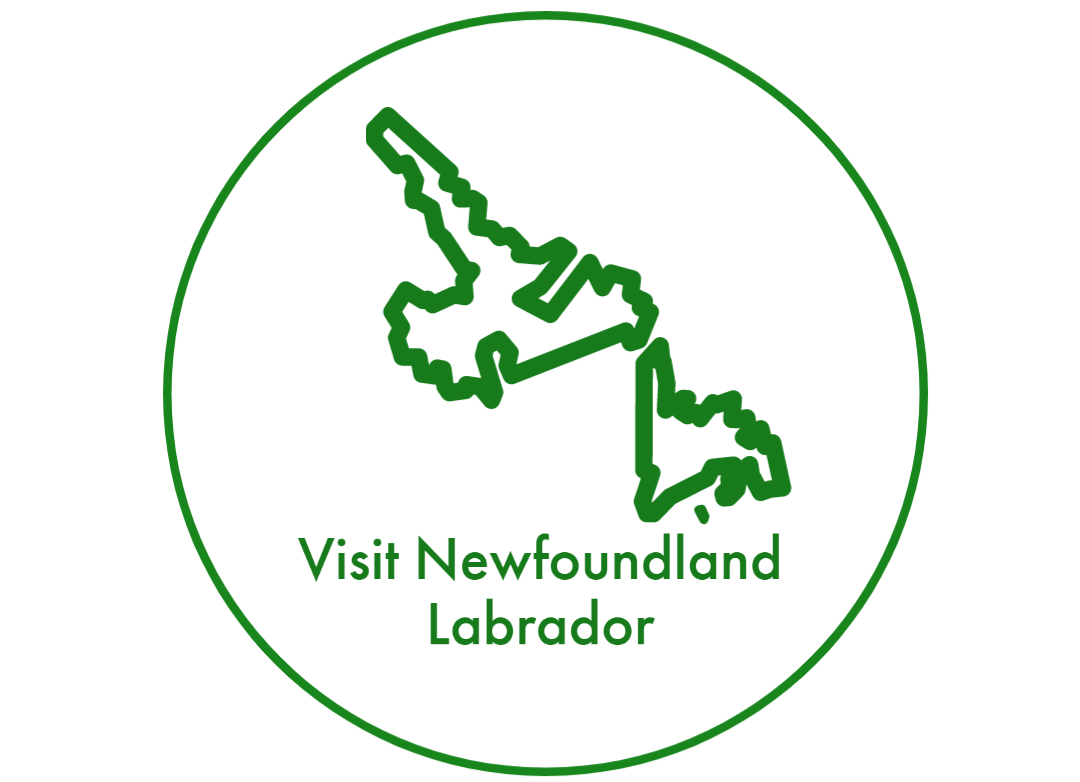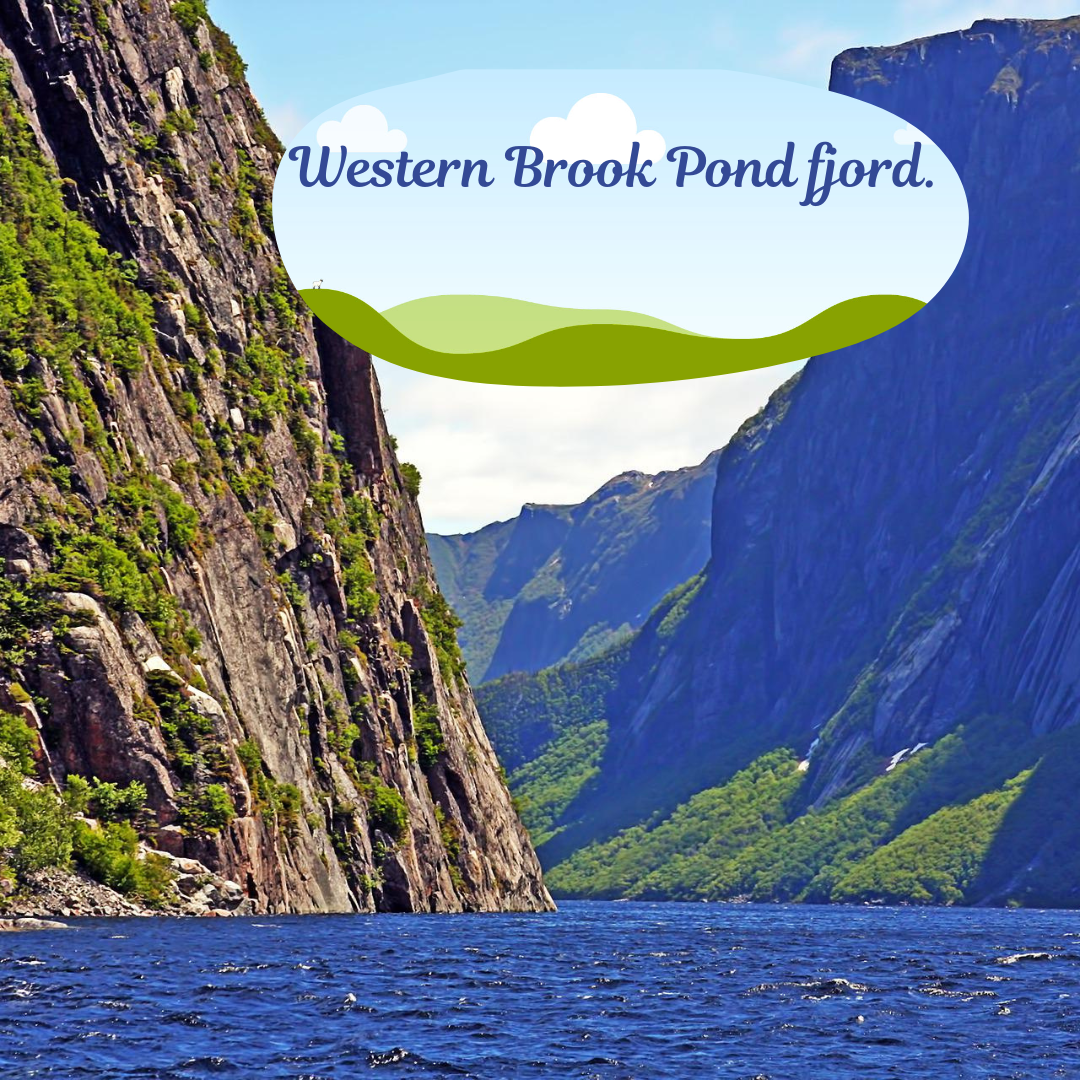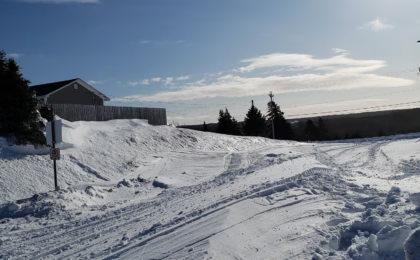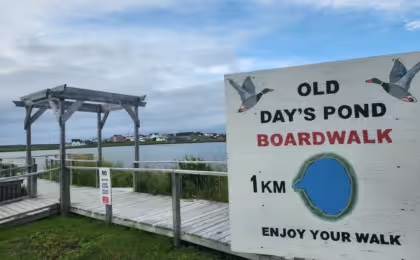Exploring the best views of Western Brook Pond Fjord
Exploring the best views of Western Brook Pond Fjord. We are Exploring Newfoundland Natural Wonder. Nestled within the pristine wilderness of Newfoundland, Canada, Western Brook Pond Fjord stands as an inspiring testament to the power of glacial forces and the beauty they sculpted. This travel guide will take you on a virtual journey to discover the wonders of Western Brook Pond Fjord, providing you with essential information, must-see attractions, outdoor activities, and tips for an unforgettable experience.
Western Brook Pond Fjord is a natural masterpiece carved by glaciers over millions of years. Located in Gros Morne National Park, this fjord stretches for kilometres, flanked by cliffs that rise above sea level. Its tranquil waters mirror the rugged landscape, creating a breathtaking paradise for nature enthusiasts and photographers.
You can fly into St. John’s International Airport to reach Western Brook Pond Fjord. From there, you can rent a car and embark on a scenic drive to Gros Morne National Park. It will take you 6 hr and 54 min via the Trans-Canada Hwy. Alternatively, you can opt for a domestic flight to Deer Lake Regional Airport, closer to the park.
The best time to visit Western Brook Pond Fjord is during the summer months of June to September. The weather is mild, and boat tours are in full swing, allowing you to explore the fjord’s beauty comfortably. Remember to bring layers, as temperatures can vary throughout the day.
Witnessing the majesty of Western Brook Pond Fjord is an attraction in itself. The fjord’s cliffs and tranquil waters offer a unique setting for various activities. Explore the fjord from above by hiking its surrounding trails. The Green Gardens Trail offers stunning coastal views, while the Gros Morne Mountain Trail provides panoramic vistas of the fjord and the park.
Embark on Bon Tours (www.bontours.ca), a boat tour that takes you into the heart of the fjord—observe the towering cliffs, cascading waterfalls, and the fjord’s serene beauty. The boat guides often share fascinating insights into the area’s geology and history. Keep an eye out for the diverse wildlife that calls the fjord home. Eagles and moose can be spotted in the area.
Capture the essence of Western Brook Pond Fjord with these photography tips:
- Take photos during sunrise and sunset for magical lighting.
- Use a wide-angle photo lens to capture the grandeur of the fjord.
- Experiment with extended exposure to capture the movement of waterfalls.
Immerse yourself in nature by camping within Gros Morne National Park. Nearby towns offer lodges, cabins, and bed-and-breakfast options for those seeking more comfort. Sample Newfoundland cuisine, known for its seafood delicacies like fish and chips, lobster, and crab. Don’t miss out on experiencing a traditional “Jigg’s dinner,” a hearty meal featuring salted beef, vegetables, and pease pudding.
Essential Tips for Visitors:
- Pack Accordingly: Prepare for varying weather conditions and bring sturdy hiking shoes.
- Reserve in Advance: If you plan on taking a boat tour, booking in advance is recommended, especially during peak season.
- Respect Nature: Practice Leave No Trace principles to protect this pristine environment.
- Stay Hydrated: Carry enough water during hikes and outdoor activities.
- Follow Regulations: Abide by park regulations and guidelines to preserve the fjord’s beauty.
Western Brook Pond Fjord offers a captivating blend of geological wonders and outdoor adventures. This natural gem promises an unforgettable journey through one of Canada most spectacular landscapes. Plan your visit and prepare to be amazed by the sheer beauty and tranquillity of the Fjord in Gros Morne National Park.
Frequently Asked Questions (FAQs) About Western Brook Pond Fjord
Q1: What is Western Brook Pond Fjord?
A1: Western Brook Pond Fjord is a stunning geological formation in Gros Morne National Park in Newfoundland, Canada. It’s a long, narrow inlet surrounded by towering cliffs and characterized by its serene waters, offering a breathtaking natural spectacle.
Q2: How was Western Brook Pond Fjord formed?
A2: The fjord was sculpted by glacial activity. As glaciers advanced and retreated, they created the deep valley holding Western Brook Pond. The valley filled with water when the glaciers melted, making the fjord we see today.
Q3: When is the best time to visit Western Brook Pond Fjord?
A3: The optimal time to visit is during the summer, from June to September. This period offers milder weather, accessible boat tours, and a chance to comfortably experience the fjord’s beauty.
Q4: How can I reach Western Brook Pond Fjord?
A4: To get to the fjord, you can fly into St. John’s International Airport or Deer Lake Regional Airport in Newfoundland. From there, rent a car for a scenic drive to Gros Morne National Park, where the fjord is situated.
Q5: Are boat tours available at Western Brook Pond Fjord?
A5: Boat tours are a popular way to experience the fjord up close. These tours take you through the heart of the fjord, offering breathtaking views of towering cliffs, waterfalls, and serene waters.
Q6: Are there hiking trails around Western Brook Pond Fjord?
A6: Indeed, the area offers several hiking trails. The Green Gardens Trail offers coastal vistas, while the Gros Morne Mountain Trail provides panoramic views of the fjord and the surrounding landscape.
Q7: What wildlife can I expect to see in the area?
A7: Western Brook Pond Fjord and its surroundings are home to wildlife, including eagles, moose, and caribou. Keep your camera ready to capture these incredible creatures in their natural habitat.
Q8: Can I go camping near Western Brook Pond Fjord?
A8: Absolutely, Gros Morne National Park offers camping facilities for those seeking an immersive nature experience. For added comfort, you can also find nearby lodges, cabins, and bed-and-breakfast accommodations.
Q9: What are some photography tips for capturing the fjord’s beauty?
A9: To capture the essence of Western Brook Pond Fjord:
- Shoot during golden hours for beautiful lighting.
- Use wide-angle lenses to capture the grandeur.
- Experiment with long exposure for waterfall shots.
Q10: What local cuisine should I try in the area?
A10: Newfoundland cuisine features delightful seafood options like fish and chips, lobster, and crab. Don’t miss the chance to savour a traditional “Jigg’s dinner,” a delicious meal with salted beef, vegetables, and pease pudding.
Q11: Are there any tips for visiting Western Brook Pond Fjord?
A11: Certainly! Remember to pack appropriate clothing for varying weather conditions. If you plan to take a boat tour, make all reservations in advance, especially during peak seasons. Respect nature by following Leave No Trace principles and adhering to park regulations.
Q12: Can I swim in Western Brook Pond Fjord?
A12: Swimming is generally not recommended in Western Brook Pond Fjord due to its cold temperatures. The fjord’s waters remain chilly even during summer, making swimming uncomfortable and potentially unsafe.
Q13: Is Western Brook Pond Fjord accessible for people with mobility challenges?
A13: While the boat tours offer a unique opportunity to experience the fjord’s beauty, the terrain can be rugged and challenging for individuals with mobility issues. It’s recommended to contact tour operators in advance to discuss any specific accessibility concerns and available options.
Q14: Are there any guided tours or interpretive programs available?
A14: Yes, there are guided boat tours available that offer informative commentary about the geology, history, and ecology of Western Brook Pond Fjord. These tours provide insights into the formation of the fjord and the diverse wildlife that calls the area home.
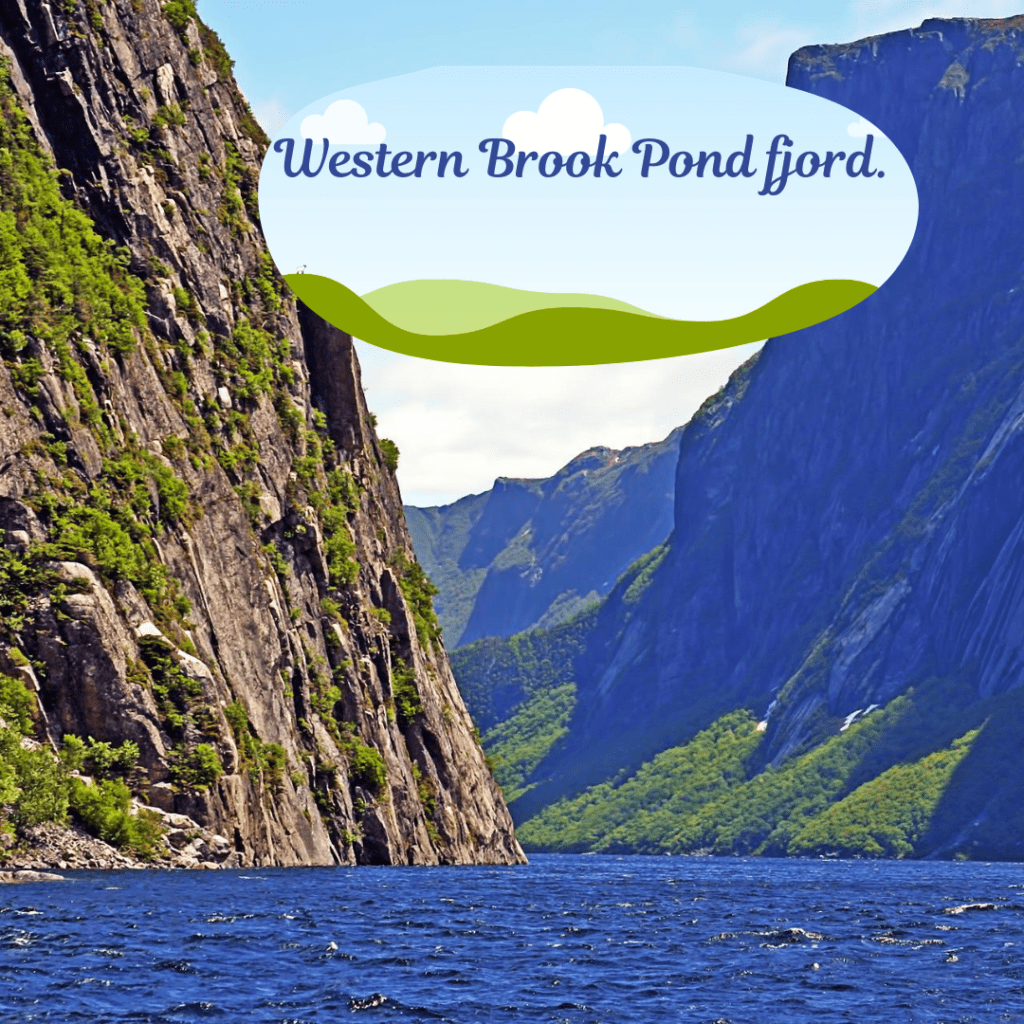
Q15: Are drones allowed around Western Brook Pond Fjord?
A15: Drone usage within Gros Morne National Park, including around Western Brook Pond Fjord, is subject to regulations. It’s essential to check with park authorities about current drone policies before planning to fly a drone in the area.
Q16: Can I fish in Western Brook Pond Fjord?
A16: Fishing is not allowed within Western Brook Pond Fjord itself. However, Gros Morne National Park offers opportunities for angling in designated areas. Visitors interested in fishing should ensure they have the necessary permits and adhere to park fishing regulations.
Q17: Are there any restrictions on camping within Gros Morne National Park?
A17: Camping within Gros Morne National Park is permitted in designated camping areas. However, specific regulations and guidelines apply to protect the park’s environment.
Q18: Are pets allowed in Western Brook Pond Fjord and Gros Morne National Park?
A18: Pets are allowed in some areas of Gros Morne National Park but must be kept on a leash. Regulations might vary, so verifying the current pet policy with park authorities is essential before bringing your furry companion.
Q19: Are there any other notable attractions near Western Brook Pond Fjord?
A19: Gros Morne National Park offers a plethora of attractions. The Tablelands, a unique geological formation, is worth exploring. The town of Rocky Harbour, near the fjord, also serves as a gateway to the park and offers amenities, accommodations, and opportunities to connect with the local culture.
Q20: Can I visit Western Brook Pond Fjord during the winter months?
A20: Winter visits to Western Brook Pond Fjord can be complex due to harsh weather conditions and limited accessibility. Many tour operators and facilities may be closed during this time. Plan your visit between June and September for the best experience.
What is Special About Gros Morne National Park?
Gros Morne National Park is unique for its dramatic geological features, including the Tablelands, a rare example of exposed Earth’s mantle. The park’s varied landscape of fjords, mountains, and coastal lowlands is a UNESCO World Heritage Site. It offers unique hiking experiences, diverse wildlife, and spectacular scenery.
How Many Days Do You Need in Gros Morne National Park?
To fully experience Gros Morne National Park, plan to spend at least 3 to 5 days. This timeframe allows for hiking, exploring geological sites, and enjoying the natural beauty and wildlife.
What is the Best Time of Year to Visit Gros Morne Park?
The best time to visit Gros Morne National Park is June to early September. The weather is mild during this period, most facilities are open, and the hiking trails are accessible.
Can You Actually Drive Through Gros Morne National Park?
Yes, you can drive through Gros Morne National Park. The park has a network of roads that connect various points of interest, making it accessible for visitors travelling by car.
Can You Hike Gros Morne Trails Without a Guide?
Yes, you can hike in Gros Morne without a guide. The park offers numerous marked trails suitable for self-guided hikes. However, hiring a guide can enhance the experience for more challenging or less well-known routes.
Are There Bears in Gros Morne?
Yes, there are black bears in Gros Morne National Park. Visitors should know their presence and follow safety guidelines to avoid encounters.
Do You Have to Pay to Visit Gros Morne National Park Areas?
Yes! There is an entrance fee to visit Gros Morne National Park Areas. Park Fees contribute to the maintenance and preservation of the park.
What is the Best Month to Visit Newfoundland?
The best month to visit Newfoundland is July. The weather is warm, the landscape is lush, and many festivals and events occur during this time.
Can You See Whales in Gros Morne?
Yes, you can see whales in Gros Morne National Park. Whale watching is popular, especially from May to September, when various species, including humpbacks and minke whales, are frequently spotted.
How Do You Get Around Gros Morne National Park?
You can drive, bike, or hike around Gros Morne National Park. The park’s roads and trails connect vital attractions, and some areas are accessible by boat.
What Towns Are Near Gros Morne National Park?
Towns near Gros Morne National Park include Rocky Harbour, Norris Point, and Woody Point. These communities provide accommodations, dining, and other visitor services.
How Long Does It Take to Hike Gros Morne?
Hiking the trail to the summit of Gros Morne Mountain typically takes 7 to 8 hours for a round trip. The hike is challenging, requiring good physical fitness.
How Do I Get to Gros Morne from St. John’s?
To get to Gros Morne from St. John’s, you can drive (about 7-8 hours), take a bus, or fly to Deer Lake Regional Airport and then drive to the park (a 30-45 minute drive).
Is There Cell Service in Gros Morne National Park?
Cell service in Gros Morne National Park is limited. Coverage is generally available in larger communities and along major roads, but it may be spotty or nonexistent in more remote areas.
How to See the Fjords in Gros Morne?
To see the fjords in Gros Morne, take a boat tour of Western Brook Pond, a stunning fjord. These tours offer spectacular views of the fjord’s cliffs and waterfalls.
What is the Hardest Hike in Newfoundland?
The Long Range Traverse in Gros Morne National Park is the most challenging hike in Newfoundland. This multi-day backcountry trek requires navigation skills and excellent physical conditioning.
Are There Black Flies in Gros Morne?
Black flies are present in Gros Morne, especially in late spring and early summer. Visitors should bring insect repellent and protective clothing.
Can Kids Hike Gros Morne?
Yes, kids can hike in Gros Morne. Family-friendly trails like the Green Gardens Trail and the Lookout Hills Trail offer moderate difficulty and scenic views.
Are There Moose in Gros Morne?
Yes, moose are common in Gros Morne National Park. They are often seen along trails and roadsides.
Do People Live in Gros Morne National Park?
There are small communities within Gros Morne National Park where people live, including Rocky Harbour and Norris Point.
Is Newfoundland Expensive to Visit?
Newfoundland can be moderately expensive to visit, especially during peak tourist season. Costs for accommodations, transportation, and activities can add up, but budget travellers also have options.
What Month Do You See Icebergs in Newfoundland?
The best months to see icebergs in Newfoundland are May and June. During this time, icebergs drift south from Greenland and can be viewed from the coast.
What is the Wettest Month in Newfoundland?
The wettest month in Newfoundland is typically October, with frequent rain and storms.
Are There Puffins in Gros Morne National Park?
While puffins are not commonly found within Gros Morne, nearby areas like Elliston, Bonavista, and Witless Bay Ecological Reserve offer excellent puffin viewing opportunities.
What Animals Live in Gros Morne?
Gros Morne is home to various animals, including moose, caribou, black bears, foxes, and numerous bird species.
What is Special About the Tablelands?
The Tablelands are unique because they are a rarely exposed section of the Earth’s mantle, thrust by tectonic forces. This geological anomaly is one of the reasons Gros Morne is a World Heritage Site.
What is the History of the Tablelands?
The Tablelands were formed over 450 million years ago during the continental collision that created the Mountains. Their unique geology has fascinated scientists and visitors.
How Long is the Tablelands Hike?
The Tablelands Trail is about 4 kilometres and takes 1.5 to 2 hours to complete. The trail offers insight into the unique geological landscape.
How to See the Tablelands?
You can see the Tablelands by hiking the Tablelands Trail or taking a guided tour offered by Parks Canada, which provides in-depth information about the area’s geology.
How Old Are the Tablelands?
The rocks of the Tablelands are over 450 million years old.
How Are the Tablelands Formed?
The Tablelands were formed when a piece of the Earth’s mantle was pushed to the surface by tectonic forces. This process is rare and has created the distinctive barren landscape of the Tablelands.
Why is Gros Morne Famous?
Gros Morne is famous for its stunning geological formations, including the Tablelands and Western Brook Pond fjord. Its diverse landscapes and status as a UNESCO World Heritage Site make it a prominent natural attraction.
What Do Newfoundland Tablelands Consist Of?
Newfoundland Tablelands consist of rock from the Earth’s mantle. The high mineral content in the stones gives the Tablelands a distinctive brownish-orange colour and barren appearance.
We hope these additional FAQs provide you with a more comprehensive understanding of Western Brook Pond Fjord and assist you in planning an enjoyable and informed trip to this natural marvel. Embrace the beauty of Gros Morne National Park and the captivating allure of the fjord for a memorable adventure. Thanks for Exploring the best views of Western Brook Pond Fjord with us.
These are the best travel planning resources you should use.
Are you looking to book your trip to Newfoundland and Labrador? Use these resources that are tried and tested by other travellers like you who vacation in Newfoundland and Labrador. Bookmark these links. Save them for future reference.
Booking Flights, Hotels or B&B: Start planning your next vacation trip by finding the best flight, hotel or b&b deals. Book Here
Finding things to do in Newfoundland and Labrador on TripAdvisor and Viator is not hard. You can enjoy boat tours, whale watching, iceberg watching, kayaking and other activities. Book all these activities on
You can also find low prices on hotels, B&B and cabins with these two providers. If you are located in Canada, the USA, the UK or Europe, use Booking.com, and if you are in Canada, the USA or anywhere else, use TripAdvisor.
Car Rental: Here is what we recommend:
When you book with Rentalcars.com, you can compare prices and find the best vehicle for your trip. Economybookings.com Display all their vehicle on the website with a detailed description. They display high-quality photos and a user rating as well. Qeeq.com serves road trip travellers like you from different countries by working with car rental companies worldwide.
Get compensated if your flight is delayed or cancelled.
AirHelp and Compensateair will help you with flight delays, cancellations, or denied boarding. All you need to do is to submit your flight details, and they will handle the claim process on your behalf. They will handle all the paperwork, airline negotiations, and legal proceedings.
Do you need more help planning your trip?
Check out our Resources Page, where we also highlight all the resources and companies you can use to assist with your planning.
